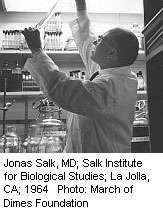A lasting legacy of science (Part 2/2)

(HealthDay)—The Salk polio vaccine trial of 1954 proved a momentous event whose impact is still felt today.
On a broad scale, the trial first fundamentally altered the way Americans viewed charities, transforming them from an indulgence catered by a wealthy few into a common cause that could be joined by all.
Most of the funding for the trial came from the March of Dimes, which was called the National Foundation for Infantile Paralysis back then.
"Until it came along, basically if you wanted to have a charity, a couple of wealthy people would come together and pool their money," said David Oshinsky, author of the Pulitzer Prize-winning Polio: An American Story. "The March of Dimes wanted the small donation from millions. Nobody was too poor to give a dime for a kid to walk again."
On a narrower but more critical scale, the trial got very little government scrutiny because government oversight of clinical testing was practically non-existent at the time.
Compared to today's tight standards for drug studies, the vaccine's testing was a freewheeling affair.
It was proven effective in a private nationwide test involving almost 2 million kids. And it was proven safe primarily through experimental inoculation of institutionalized children, a decision that raised eyebrows even at the height of polio fears in the 1950s, according to Oshinksy.
In addition, federal regulators served more as boosters than skeptical observers for the larger trial, evidenced by the fact that they issued five licenses to produce the vaccine on the very day in 1955 that researchers announced the successful results.
"There's so much government protocol today," said Oshinsky. "You never would have anything like that these days. They never would have this today."
But the success of the vaccine did give rise to the modern era of government pharmaceutical regulation—in large part because of one deadly mistake in the process at the time.
California-based Cutter Laboratories, one of the first five companies licensed by the United States to mass-produce Dr. Jonas Salk's vaccine, released a bad batch just days after the vaccine was approved.
It happened in April 1955, and the firm failed to completely kill off the live virus in the vaccine batch, which was then given to more than 200,000 children in five states.
The shots from that batch caused 40,000 new cases of polio, left 10 children dead and caused varying degrees of paralysis in 200 others.
The "Cutter Incident," as it is known, prompted federal officials to step up oversight of drug manufacturers, said Daniel Wilson, a history professor at Muhlenberg College in Allentown, Pa., who has written three books on the history of polio in the United States.
"That forced the government to improve its oversight of vaccine production to make sure the laboratories are doing it right," Wilson said.
But with that oversight has come public skepticism.
"The polio vaccine trials were back at a time when the public trusted science and trusted scientists," said Dr. Johanna Goldfarb, director of the Cleveland Clinic's Center for Pediatric Infectious Diseases. "At the time, it was amazing that nearly 2 million children would participate in a field trial and that they could have results within a year. That would be near impossible now."
Also, she added, the growing distrust of science in some quarters that has given rise to anti-vaccine movements almost certainly would prevent so many parents from allowing their children to participate in such a trial.
More information: To read part one of HealthDay's two-part series on Dr. Jonas Salk's revolutionary vaccine for polio, click here.
Paul Alexander, of Dallas, has spent 61 of his 67 years imprisoned in an iron lung. But that's just a part of his remarkable life. To read his story, click here.
Copyright © 2014 HealthDay. All rights reserved.



















